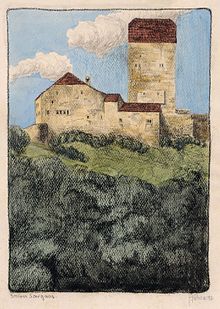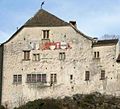Sargans Castle
| Sargans Castle | ||
|---|---|---|
|
Sargans Castle in the view from the southeast. |
||
| Creation time : | 12th Century | |
| Geographical location | 47 ° 3 '0.7 " N , 9 ° 26' 14.2" O | |
|
|
||
The Sargans Castle is a castle above Sargans in the canton of St. Gallen in Switzerland. The castle and the town formed a fortress.
Sargans Castle was first mentioned in 1282 when Countess Elisabeth von Werdenberg-Sargans was issued a certificate for a sale of goods.
history
Until 1480
Under Count Hugo von Montfort (* around 1160, † 1228), the presumably existing small castle complex was expanded at the beginning of the 13th century. The keep with its tinned curtain wall is the oldest surviving part of the complex. However, the archaeologist Franziska Knoll-Heitz found a corner of the wall that indicates the foundations of an older building, as the tower was built over these remains of the wall.
Around the middle of the 13th century, the plant was under Hartmann I . Headquarters of the Counts of Werdenberg-Sargans. At this time, the Palas , the largest building in the entire complex, was probably built on the west side. In 1459 it collapsed in an earthquake. Reconstruction began in 1460 and the so-called rear lock was added to the tower in the eastern part. Because of the risk of collapse, this part was grinded after 400 years and today's viewing terraces were built in its place.
The year numbers 1506 on a roof beam of the palace and the numbers 1508 and 1510 on lintels indicate, however, that the reconstruction dragged on until the beginning of the 16th century.
Subject territory of the confederates
In 1405 Sargans was besieged by them during the Appenzell Wars and during the Old Zurich War (1436–1450) the town was burned down, the castle was besieged , but remained unscathed. However, part of the facility collapsed later. In 1483 the seven old federal towns acquired the county of Sargans , which became subject to the confederates. From 1459 to 1798 they administered this property as common rule .
Because the castle was to become the official seat of the ruling bailiffs , the hall and the corresponding rooms also had to be refurbished. The audience room was on the first floor in the south corner; today the restaurant is located there. The year 1510 can be found on a supraport in the northeast corner. A recessed space in the thick wall bears the incised inscription:
«Diss.stübli.is.made.all.vogten.for.good.Jar. von.hansen.Jouchen.von.Uri.Der.zit.Landvuogt.1537. »
The room is therefore called «Landvogteistübli». Several coats of arms remind of the ruling bailiffs Zwyssig, Ceberg, Balthasar and Göldin von Tiefenau. The bailiffs' living quarters are separated by a corridor and are furnished with late Gothic wall and ceiling panels, alcoves and the carved coat of arms of Bailiff Johann Caspar Meyer von Baldegg . There is also the "Agnesstube", named after the penultimate countess, Agnes von Matsch . Today the parlor is part of the restaurant.
The oldest wall decoration in the district court room dates from 1580, when Daniel Tettling was bailiff , and shows the coats of arms of the oldest bailiffs from the canton of Schwyz. The passage under the hall from the Zwinger to the castle courtyard also has paintings from 1581 and coats of arms of bailiffs from the 17th century.
In 1611 the bailiff at that time was commissioned by the daily statute to affix the coats of arms of the places of origin of the ruling bailiffs on the outer wall of the palace, where they can still be seen today: Zurich, Lucerne, Uri, Schwyz, Obwalden, Nidwalden, Zug, Glarus and, after the Toggenburg War , from 1712, also Bern. 181 bailiffs replaced each other after each two-year term in office in the castle.
After 1800
After the French Revolution , the palace became the property of the state in 1798 and, through mediation, came into the possession of the newly founded canton of St. Gallen in 1803 . In 1811 it was turned into a school after the great fire in the city . Johann Georg von Toggenburg , who had been raised to the rank of French count in 1832, bought Sargans Castle as a private citizen in 1834. Since then he has called himself "Count of Toggenburg-Sargans". The addition Sargans refers to a property of a purely private nature and has nothing to do with a nobility particle. However, the old Toggenburg liens had liens on the County of Sargans , which had become obsolete when they expired in 1436 and therefore the boldness of the acquisition of Sargans Castle in particular is to underline the traditional descent from the old Toggenburg counts ( extinct in the male line entitled to inheritance in 1436), obviously. The Austro-Grisons family from Toggenburg never lived in the castle and let it fall apart. In 1899 it was purchased by the local community of Sargans.
The castle was extensively restored for the first time after 1900. In 1969/70 the facade and walls were subjected to a further renovation with the help of Heimatschutz and the federal government and canton of St. Gallen.
In addition to a restaurant, the castle has housed a local history museum since 1966 , which was reopened as the Sarganserland Museum in 1983 after a renovation .
tower
The tower, which is covered with a hipped roof, measures 8.5 by 5.3 m inside; the wall thickness on the lower floors of the tower varies between 2.5 and 2.1 m. The lower parts are made of tufa blocks that were broken above the castle; the upper parts consist of partially plastered masonry.
The five-story tower was built as a residential tower; the former high entrance is on the southeast side on the first floor. The second floor is illuminated by a single arched window on the south side. The living area was on the third floor, where traces of a fireplace can be seen. In the attic, the now walled battlements that once lined the tower can still be seen.
The castle courtyard connects to the north and west of the keep, which is protected by a strong curtain wall and a kennel in the west. Inner buildings were always attached to the keep, which kept the curtain walls free. These buildings were rebuilt or demolished several times. This is how the "Grafenstube" was created on the south side of the tower, of which there are still two window arches with seating steps. Remnants of paintings discovered in 1900 during a renovation show medieval life.
Sargans Castle, view from the east. In the background the Gonzen
Sarganserland Museum
The previous local history museum was reopened in 1983 as the Museum Sarganserland in the castle tower. In the same year it was named European Museum of the Year and in 1987 it was included among the 37 most visited museums in the world. The museum is part of the Sardona Geopark .
It shows a permanent exhibition on the history and culture of the Sarganserland as well as regular special exhibitions. The trot with the heavy staggering tree dates from the 16th century and shows that vines have been planted in the Sarganserland for more than 1000 years and that, thanks to the blow dryer , a good wine is made from them. The museum is open daily from April 1st to October 31st.
literature
- Mathias Bugg: Sargans Castle around 1900. Commemorative publication for the anniversary «100 years Sargans Castle owned by the Sargans parish». 1st edition 1999, 2nd edition 2007.
- Mathias Bugg: Sargans (castle) . In: Historisches Lexikon des Fürstentums Liechtenstein, vol. 2, p. 809. Zurich and Vaduz 2013.
Web links
- Official website of the Museum Sarganserland
- http://schloss-sargans.blogspot.com/
- Castle world: Sargans Castle
Individual evidence
- ↑ Sargans Castle. Sargans parish, accessed February 14, 2014 .
- ^ Friedrich VII., Count of Toggenburg ; † April 30, 1436, in the ADB; see. also Johann Caspar Zellweger , History of the Appenzell People: With a Map , Volume 1 (1830), p. 368 , and Memoranda of the Bavarian Academy of Sciences , Volume 4, Munich 1814, p. 184 f.
- ^ Museum Sarganserland: History
- ^ Sargans Castle: Museum Sarganserland ( Memento of the original from August 10, 2015 in the Internet Archive ) Info: The archive link has been inserted automatically and has not yet been checked. Please check the original and archive link according to the instructions and then remove this notice.










